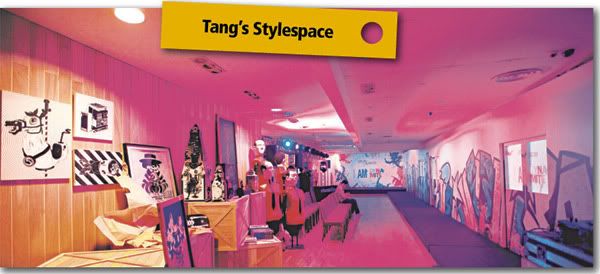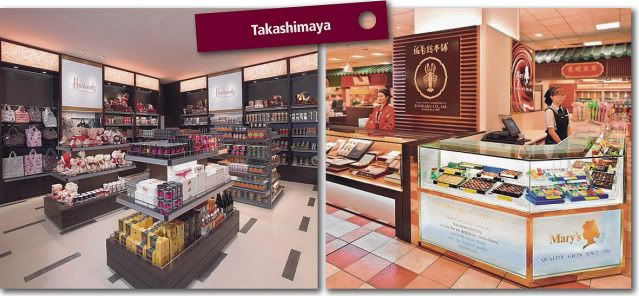Business Times - 29 Jul 2011
Stores get hip and happenin'



The one-stop-shop business model of department stores of yore is in trouble. As customers become increasingly spoilt for choice from smaller speciality stores, outlets which don't want to get mauled at the mall are upping their game to stay in it, reports MELISSA LWEE-RAMSAY
IF THERE was any indication that big department store shopping is out and niche buying experiences are in, Robinson's probably did not get that memo. With its new 1,932.38 sq m luxury concept store at Marina Bay Sands, it joins the ranks of several retail stalwarts that have spent the last year or so raising their game to maintain their hold on an increasingly fickle - and not at all loyal - clientele.
From a merchandising standpoint, we have become much more fashion-forward and sophisticated,' says Jim McCallum, head of Asia, The Robinson Group of Stores. 'We are taking a bolder stance towards changing things.'
That means shaking off its perceived 'uncool' image with the likes of Hollywood favourite Aryn K, popular New York accessories label Botkier and London jewellery house Mawi. The store even managed to attract growing local beauty chain Skin Inc to open its first department store branch there.
The newly revamped eight-floor Courts store in Orchard is another example.
On top of products, the 4,087.73 sq m space incorporates interactive displays and lifestyle corners in the form of Chill Out Zones with free Wifi and coffee.
'Putting in Chill Out Zones in the store is our way of completing our customers' shopping experience,' explains CEO of Courts Asia, Terry O'Connor.
'Shopping for electronics and home furnishing products can be a stressful affair - here, we invite our customers to relax, enjoy a cup of Nespresso while checking out the latest news and information from the Internet, with our compliments.'
No longer just about price
It's a far cry from how Courts operated since its launch in 1974, to Mr O'Connor, it is a necessary progression in order to reach out to the consumers today.
'Naturally, the spending patterns of consumers have changed over the years,' he explains. 'Today, it is no longer just about price. Besides just being affordable, consumers are now looking for a unique shopping experience, coupled with great customer service.'
Adds Robinson's Mr McCallum,: 'Singapore 10, 15 years ago, had a kind of local mentality but that's changing with education, with significant numbers of Singaporeans educated abroad and coming home to work here. Because of this, the consumer is more sophisticated, more demanding. They've seen products elsewhere that they would like to see here.'
Not to be outdone, other major players in the market have likewise been ramping up their efforts. Takashimaya Department Store for one recently reworked its popular Food Hall to present a fresh shopping experience to their customers.
By introducing a new line-up of eateries like Mignon Steakhouse, Fisherios Fish N Chips and Baikohken Ramen and gourmet groceries from Leonardi, La Favorita Figh and Fine Cheese Company, the aim is to 'excite and surprise our customers through introduction to new brands and atmosphere,' says its spokesperson.
This is on top of the revamps of various other parts of the roughly 18-year-old department store (it launched in 1993) including a reworked Ladies Wear Young Fashion zone to incorporate local fashion labels, the expansion of the Golf and Sports Active wear zone over the past year and a newly expanded Household and Cookware zone in May. A revamped Food Hall Sweets & Snacks area is similarly in the pipeline in the upcoming months.
Given all the effort that these retailers are exerting, it then begs the question as to why the need for all these changes, particularly over the past year.
Singapore Management University's associate professor of marketing practice Seshan Ramaswami believes that these new initiatives are all a response to the increasingly competitive retail climate in Singapore given the launch of new malls on the island and the new kinds of consumers attracted by the integrated resorts.
'Singapore's retailing scene is forever evolving,' he says. 'Given a population for whom shopping is a national hobby, every new additional mall presents a bit of a threat to the existing retailers, even the big ones,' he says.
'Consumers do get tired of the same old shopping routines and are always looking for something new and unique, just for the extra sensory stimulation provided by novelty.
For retailers, it means tinkering with the layout, and assortment - sometimes going upmarket in the ambience and assortment, or sometimes going down-market by offering sales, or bargain areas to attract new customers and re-invigorate current customers.'
Agrees Savills' senior director Sulian Tan-Wijaya: 'Many years ago, department stores were the main shopping destinations for many shoppers who saw them as 'one-stop' shops. With the proliferation of new local and international brands, shoppers no longer see the department store as a must-go shopping destination.
'Department stores are no longer as dominant as many years ago, they will have to constantly refresh their merchandise, store formats and concepts in order to keep up with evolving trends and consumers' tastes.'
With an increasingly fickle consumer base, retailers know that constant change and novelty is key.
Which is why earlier this year, iconic department store TANGS transformed its previous Children's concept into STYLESPACE ON 4 - a specially curated fashion space that serves as a venue for fringe events and features a rotating roster of international and local labels.
'Since April, STYLESPACE has taken on several themes, with its current being an outdoor Summer one featuring outdoor furniture and lifestyle merchandise, some of which are making their appearance for the first time at TANGS,' says its vice-president for marketing & communications Gerry Rezel. 'This 'pop-up' concept idea injects freshness to the store.
'We're constantly evolving to stay relevant with our target customers and will definitely be including 'newness' as a key factor and as an example, refreshing STYLESPACE ON 4 in every campaign, with fresh new events and brands.'
Over at PARCO - which describes itself more as 'store-in-store concept' rather than a department store - new talent is guaranteed annually at PARCO Marina Bay which opened in Singapore last year.
This is thanks to the next NEXT fashion incubator project which started in October 2009 with a vision to groom up-and-coming local designers who are then retailed at PARCO. So far 37 designers and their labels have been groomed, including success stories like max.tan, Chalk and Mae Pang.
'With the influx and intense competition from foreign masstige to luxury brands, local retailers are constantly challenged to take these brands on and stay in the forefront of the shoppers' consciousness,' says Shuichi Hidaka, managing director, PARCO Singapore) Pte Ltd. 'They have to ask themselves - at every turn - do I have what it takes to get shoppers in, and then enough to keep them interested, engaged and entertained. How can I keep things fresh enough to make them want to come back.'
'PARCO next NEXT, specifically, has really caught the media's eye. They recognise the talent they are seeing in our young designers and share our belief that supporting local fashion is so important. Our home-grown talent has an important role to play in Singapore's fashion/retail scene. PARCO next NEXT adds to the overall versatility and vibrancy of the retail scene, and offers a one-of-a-kind shopping experience.'
Challenges of retail-dense areas
Regardless, it is almost certain that moving forward, the competition would only grow stiffer and retailers would have to keep upping their game in order to well, stay in the game.
SMU's Dr Ramaswami even goes so far as to predict that the classic 'one-stop shop' department store business model is 'going to be in trouble' here.
He explains that in retail-dense areas like Singapore, department stores face a lot more direct competition on all fronts, be it from the speciality stores to stores like Carrefour, Sheng Siong and Mustafa Centre fighting at a lower level to competition from online businesses.
'The format is in trouble I think, and is trying hard to constantly redefine itself, and keep doing novel things to extend the life cycle of the format in these Asian cities,' he says.
The fact that Singaporeans are spoilt for choice, doesn't help, warns Savills' Ms Tan-Wijaya.
'Customers have so many shops to choose from, they can even shop online and find most brands these days. If a department store does not keep up with ever changing customers' tastes, retail trends and shopping styles, they will lose market share to independent retailers and online shopping,' she concludes.
'Having said that, some department stores are proactive in reviewing and updating their merchandise mix to ensure they stay relevant to shoppers' ever-changing tastes. They also continue to improve their store design, displays and concepts to create a more holistic shopping experience. Those who do not will continue to lose market share and struggle to stay relevant.'

No comments:
Post a Comment